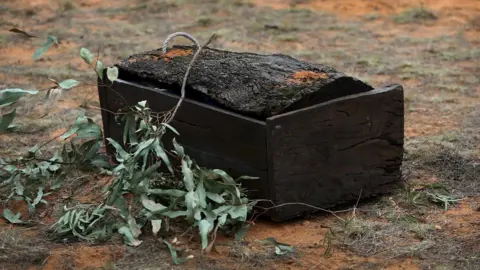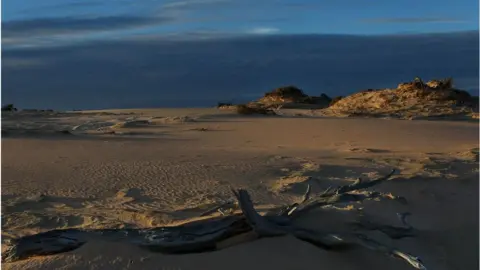Mungo Man: 42,000-year-old Aboriginal remains to be reburied
 Getty Images
Getty ImagesThe remains of 108 Aboriginal people who died about 42,000 years ago will be reburied in outback Australia, years after they were first dug up without permission.
These include the remains of Mungo Man, which was famously discovered in 1974 and helped rewrite Australia's history.
The decision comes after the federal government finalised a four-year-long formal assessment about the reburial.
But some indigenous groups claim they were not consulted in this process.
Between 1960 and 1980, there were a flurry of archaeological finds.
During this time, researchers found the remains of 108 Aboriginal individuals in Lake Mungo and Willandra lakes, part of the Willandra world heritage area, about 750km (470 miles) west of Sydney - including the remains of an aboriginal man who was dubbed Mungo Man.
At the time, his remains were the oldest evidence of humans living in Australia, and evidence of the first, recorded ceremonial burial - a sign that there had been a long history of civilisation, as early as 42,000 years ago.
That record was broken when another 65,000-year-old site was discovered elsewhere in 2017.
 Getty Images
Getty ImagesHowever the future of these ancient remains is still a matter of debate.
Campaigners say many remains, removed without permission, are yet to be returned - with some housed in museums overseas. In the case of Mungo Man, indigenous Australians said the removal of his remains caused great pain.
Mungo Man was finally returned to Mungo National Park, where he was found, in 2017, after being kept in storage at the Australian National University in Canberra.
In 2018, the Australian government decided to rebury all 108 remains - in what they described as an effort to accommodate the wishes of Aboriginal groups. On Wednesday, the government finally approved the reburial of the remains over the coming month, at 26 anonymous locations in national parks.
"Forty-two thousand years ago, Aboriginal people were living - and thriving - on the edge of what was then a rich lakeside. In the last four decades their remains have been removed, analysed, stored, and extensively investigated in the interests of western science.", Federal Environment Minister Sussan Ley said.
While the government asserted that they had listened to the local Aboriginal community, some of the community members feel let down by the process.
Local papers, quoting some locals, said they felt "bitter disappointment" as not all the owners of the remains were consulted.
Michael Young, a Paakantyi man from the community, said the central government continued to make decisions without them, according to an ABC News report.
"It is our place. It is our identity."
